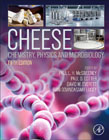
Cheese: Chemistry, Physics and Microbiology
McSweeney, Paul L.H.
Cotter, Paul D.
Everett, David W
Lucey, Rani Govindasamy
Cheese: Chemistry, Physics and Microbiology, Fifth Edition provides a comprehensive overview of the chemical, biochemical, microbiological, and physico-chemical aspects of cheese, taking the reader from the rennet and acid coagulation of milk to the role of cheese and related foods in addressing public health issues. This updated revision, the most comprehensive work on the science of cheese, addresses the basic definition of cheese, along with the diverse factors that affect its quality. Understanding these fermented milk-based food products is vital to a global audience. Divided in two volumes, this book contains by far the most comprehensive coverage of the scientific aspects of this important dairy product, covering all aspects of cheese manufacture and ripening from the standpoint of basic science (vol 1). In addition, coverage is included of all major families of cheese (vol 2). Thoroughly revised edition brings updated, new chapters that cover cheese structure, digestibility, acid-curd, and acid/heat coagulated cheesesOffers practical explanations and solutions to challenges, including case studiesPresents content that is ideal for those learning and practicing the art of cheesemaking at all levels of research and production INDICE: Volume 1: GENERAL ASPECTS Section 1. Introduction 1 Cheese: An overview 2 Milk for cheesemaking Section 2. Coagulation of milk 3 Rennets: applied aspects 4-new authors Chymosin and other acid proteinases 5 Rennet-induced coagulation of milk 6 Syneresis of the rennet coagulum 7 Formation and structure of acid milk gels Section 3. Starters & Manufacture 8 Starter Cultures: general aspects 9 Genetics of lactic acid bacteria 10 Bacteriophage 11-new authors Secondary and adjunct starters 12 Other components of the cheese microbiota 13-new authors Salt in cheese: physical, chemical and biological aspects. Water activity Section 4. Cheese Ripening 14 Cheese ripening: introduction and overview 15 Microbiological changes during ripening 16 Biochemistry of cheese ripening. 1. Metabolism of residual lactose and of lactate and citrate 17 Biochemistry of cheese ripening. 2. Lipolysis and metabolism of fatty acids 18-new authors Biochemistry of cheese ripening. 3. Proteolysis 19-new authors Biochemistry of cheese ripening. 4. Amino acid catabolism 20 Cheese flavour: Sensory and instrumental analysis 21 Acceleration and modification of cheese ripening 22 Structure and texture of cheese Section 5. Public Health Aspects 23 Growth and survival of microbial pathogens in cheese 24 Mycotoxins in cheese 25-new authors Nutritional aspects of cheese 26-new chap Cheese structure and digestibility Volume 2: CHEESE TECHNOLOGY AND MAJOR CHEESE GROUPS Section 1. Cheese Technology 27-new authors Factors affecting cheese quality 28 General aspects of cheese technology 29-new authors Application of membrane separation technology to cheese production 30-new authors Low-fat and low sodium cheese 31-new authors Cheese as a food ingredient (inc EMC) 32 Legislation 33 Diversity of cheese varieties: an overview 34 Extra-hard varieties 35-new authors Cheddar and related dry-salted cheese varieties 36 Gouda and related cheeses 37 Cheese with propionic acid fermentation 38 Surface mould-ripened cheeses 39 Blue cheese 40 Bacterial surface-ripened cheeses 41-new authors Varieties ripened under brine 42 Pasta-filata cheeses 43 Cheeses from ewes' and goats' milk 44 Cheeses from buffalo milk 45 Quarg 46-new chap Acid-curd and acid/heat coagulated cheeses 47 Scandinavian whey cheeses 48-new authors Processed cheese products
- ISBN: 978-0-443-15956-5
- Editorial: Academic Press
- Encuadernacion: Cartoné
- Páginas: 1360
- Fecha Publicación: 01/02/2025
- Nº Volúmenes: 1
- Idioma:
